Im working on a project where I need to make a custom square camera. Im working on a sample project right now and ill upload the code.
The game plan is to open a camera preview. Draw views on top to give the illusion that it is a square camera. Take the full screen picture and lastly crop the picture.
Everything seems to be going according to plan but when I finally take the picture the result of the full screen picture that gets saved in my phone is different from the picture I have taken. Let me illustrate the expected result and the final result to show you what the problem is:
As you can see I can see when I look at the saved picture in the gallery I can see the desk on the left and also parts of the wall on the right which are not in my camera preview when I took the picture.
I have tried a variety of different things in my camera preview class but as of present I am using the camera preview class found in one of the answers on this post: Android Camera Preview Stretched
I am currently only posting my camera preview class but if you need my main/xml etc I would be more then willing to put it up. I feel I have searched far and long but I can not figure out what is going on. Thanks!
public class CameraPreview extends SurfaceView implements SurfaceHolder.Callback {
private static final String TAG = "CameraPreview";
private Context mContext;
private SurfaceHolder mHolder;
private Camera mCamera;
private List<Camera.Size> mSupportedPreviewSizes;
private Camera.Size mPreviewSize;
public CameraPreview(Context context, Camera camera) {
super(context);
mContext = context;
mCamera = camera;
// supported preview sizes
mSupportedPreviewSizes = mCamera.getParameters().getSupportedPreviewSizes();
for(Camera.Size str: mSupportedPreviewSizes)
Log.e(TAG, str.width + "/" + str.height);
// Install a SurfaceHolder.Callback so we get notified when the
// underlying surface is created and destroyed.
mHolder = getHolder();
mHolder.addCallback(this);
// deprecated setting, but required on Android versions prior to 3.0
mHolder.setType(SurfaceHolder.SURFACE_TYPE_PUSH_BUFFERS);
}
public void surfaceCreated(SurfaceHolder holder) {
// empty. surfaceChanged will take care of stuff
}
public void surfaceDestroyed(SurfaceHolder holder) {
// empty. Take care of releasing the Camera preview in your activity.
}
public void surfaceChanged(SurfaceHolder holder, int format, int w, int h) {
Log.e(TAG, "surfaceChanged => w=" + w + ", h=" + h);
// If your preview can change or rotate, take care of those events here.
// Make sure to stop the preview before resizing or reformatting it.
if (mHolder.getSurface() == null){
// preview surface does not exist
return;
}
// stop preview before making changes
try {
mCamera.stopPreview();
} catch (Exception e){
// ignore: tried to stop a non-existent preview
}
// set preview size and make any resize, rotate or reformatting changes here
// start preview with new settings
try {
Camera.Parameters parameters = mCamera.getParameters();
parameters.setPreviewSize(mPreviewSize.width, mPreviewSize.height);
parameters.setFocusMode(Camera.Parameters.FOCUS_MODE_CONTINUOUS_PICTURE);
mCamera.setParameters(parameters);
mCamera.setDisplayOrientation(90);
mCamera.setPreviewDisplay(mHolder);
mCamera.startPreview();
} catch (Exception e){
Log.d(TAG, "Error starting camera preview: " + e.getMessage());
}
}
@Override
protected void onMeasure(int widthMeasureSpec, int heightMeasureSpec) {
final int width = resolveSize(getSuggestedMinimumWidth(), widthMeasureSpec);
final int height = resolveSize(getSuggestedMinimumHeight(), heightMeasureSpec);
if (mSupportedPreviewSizes != null) {
mPreviewSize = getOptimalPreviewSize(mSupportedPreviewSizes, width, height);
}
float ratio;
if(mPreviewSize.height >= mPreviewSize.width)
ratio = (float) mPreviewSize.height / (float) mPreviewSize.width;
else
ratio = (float) mPreviewSize.width / (float) mPreviewSize.height;
// One of these methods should be used, second method squishes preview slightly
setMeasuredDimension(width, (int) (width * ratio));
// setMeasuredDimension((int) (width * ratio), height);
float camHeight = (int) (width * ratio);
float newCamHeight;
float newHeightRatio;
if (camHeight < height) {
newHeightRatio = (float) height / (float) mPreviewSize.height;
newCamHeight = (newHeightRatio * camHeight);
Log.e(TAG, camHeight + " " + height + " " + mPreviewSize.height + " " + newHeightRatio + " " + newCamHeight);
setMeasuredDimension((int) (width * newHeightRatio), (int) newCamHeight);
Log.e(TAG, mPreviewSize.width + " | " + mPreviewSize.height + " | ratio - " + ratio + " | H_ratio - " + newHeightRatio + " | A_width - " + (width * newHeightRatio) + " | A_height - " + newCamHeight);
} else {
newCamHeight = camHeight;
setMeasuredDimension(width, (int) newCamHeight);
Log.e(TAG, mPreviewSize.width + " | " + mPreviewSize.height + " | ratio - " + ratio + " | A_width - " + (width) + " | A_height - " + newCamHeight);
}
}
private Camera.Size getOptimalPreviewSize(List<Camera.Size> sizes, int w, int h) {
final double ASPECT_TOLERANCE = 0.1;
double targetRatio = (double) h / w;
if (sizes == null)
return null;
Camera.Size optimalSize = null;
double minDiff = Double.MAX_VALUE;
int targetHeight = h;
for (Camera.Size size : sizes) {
double ratio = (double) size.height / size.width;
if (Math.abs(ratio - targetRatio) > ASPECT_TOLERANCE)
continue;
if (Math.abs(size.height - targetHeight) < minDiff) {
optimalSize = size;
minDiff = Math.abs(size.height - targetHeight);
}
}
if (optimalSize == null) {
minDiff = Double.MAX_VALUE;
for (Camera.Size size : sizes) {
if (Math.abs(size.height - targetHeight) < minDiff) {
optimalSize = size;
minDiff = Math.abs(size.height - targetHeight);
}
}
}
return optimalSize;
}
}

